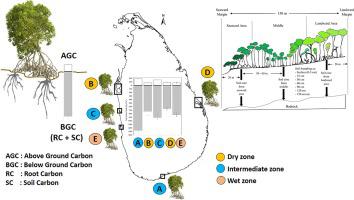Geoderma ( IF 5.6 ) Pub Date : 2021-02-05 , DOI: 10.1016/j.geoderma.2021.114929 Pestheruwe Liyanaralalage Iroshaka Gregory Marcelus Cooray , Kodikara Arachchilage Sunanda Kodikara , Marappullige Priyantha Kumara , Uthpala Indeewari Jayasinghe , Sanduni Kanishka Madarasinghe , Faird Dahdouh-Guebas , Daniel Gorman , Mark Huxham , Loku Pulukkuttige Jayatissa

|
Sri Lanka is at the forefront of global mangrove conservation. It is the first country to officially protect all its remaining mangrove forests and has embarked on an ambitious plan to restore 10,000 ha of wetland during the United Nations Decade of Ecosystem Restoration. One incentive for this conservation effort is a recognition, based on research mostly done elsewhere, of the importance of mangroves for carbon sequestration and storage. However, a lack of data on Sri Lankan mangrove carbon pools, especially on soil organic carbon, has been recognized as a major impediment to national climate change mitigation strategies. The current work examined both above and below-ground carbon stocks of five important mangrove forests in Sri Lanka (Rekawa, Puttalam-Kalpitiya, Pambala-Chilaw, Batticaloa and Negombo) which are situated in the three major climate zones (dry, intermediate and wet) and therefore sample the main climatic drivers of spatial variability. Above-ground carbon, below-ground root carbon and soil carbon stocks of mangroves in Sri Lanka ranged from 75.5 to 189.1 Mg C ha−1, 7.9 to 14.3 Mg C ha−1 and 643.6 to 1253.6 Mg C ha−1, respectively. The highest total mangrove carbon stock was recorded from the Rekawa lagoon which is in the intermediate climate zone (1455.4 Mg C ha−1) while the lowest was found in the Batticaloa lagoon in the dry zone (734.7 Mg C ha−1). Soil carbon stocks were substantially higher in the places where vegetation biomass and stand densities are high. Soil comprised 83–90% of the total mangrove carbon stocks at all sites, highlighting the large potential for release into the atmosphere as carbon dioxide if these habitats are disturbed. Overall, our study contributes important data that broadens our current understanding of how mangrove organic carbon pools vary spatially and with climatic zone.
中文翻译:

气候和潮间带分区带动斯里兰卡红树林的碳储量变化
斯里兰卡处于全球红树林保护的最前沿。它是第一个正式保护其所有剩余红树林的国家,并已着手一项雄心勃勃的计划,以在联合国生态系统恢复十年期间恢复10,000公顷的湿地。这项保护工作的动机之一是,根据一项主要在其他地方进行的研究,人们认识到红树林对于固碳和封存的重要性。但是,人们认识到缺乏关于斯里兰卡红树林碳库,特别是土壤有机碳的数据,这是国家减缓气候变化战略的主要障碍。当前的工作研究了斯里兰卡五个重要的红树林的地上和地下碳储量(Rekawa,Puttalam-Kalpitiya,Pambala-Chilaw,Batticaloa和Negombo)位于三个主要的气候区(干燥,中间和潮湿),因此对空间变异的主要气候驱动因素进行了采样。斯里兰卡红树林的地上碳,地下根系碳和土壤碳储量为75.5至189.1 Mg C ha-1,7.9至14.3的MgÇ公顷-1和643.6至1253.6的MgÇ公顷-1分别。最高的总碳红树股票从Rekawa泻湖这是在中间气候区记录(1455.4镁Ç公顷-1),而在最低的干区(734.7镁ç公顷拜蒂克洛泻湖发现-1)。在植被生物量和林分密度高的地方,土壤碳储量大大增加。在所有地点,土壤构成了红树林碳储量的83–90%,这突显了如果这些栖息地受到干扰,则有很大的潜力以二氧化碳的形式释放到大气中。总体而言,我们的研究提供了重要的数据,从而拓宽了我们目前对红树林有机碳库如何在空间和气候带上变化的理解。











































 京公网安备 11010802027423号
京公网安备 11010802027423号